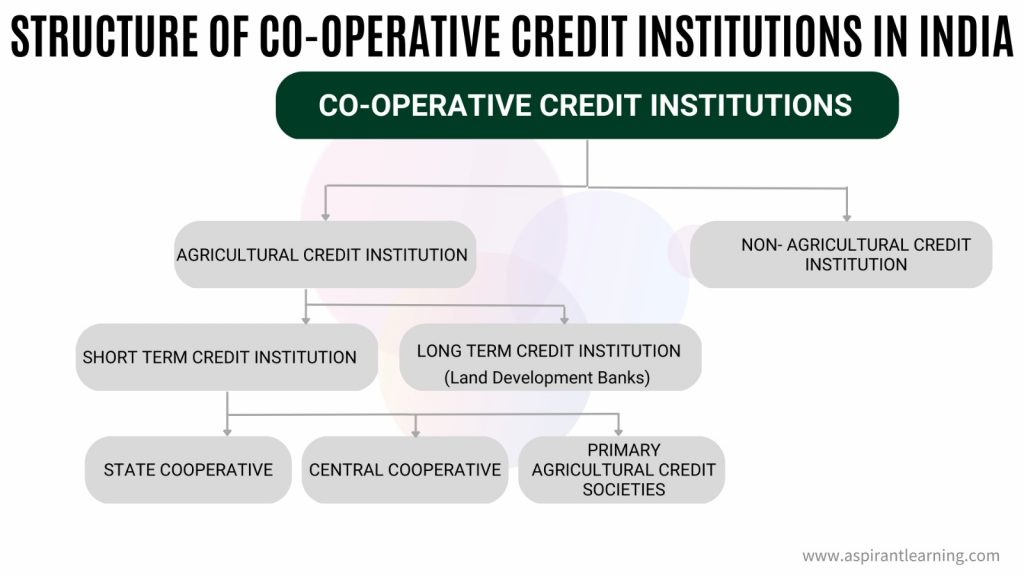News Highlights:
- The Union Budget has announced Rs 2,516 crore for the computerisation of 63,000 Primary Agricultural Credit Societies (PACS) over the next five years.
- The computerisation of PACS aims to bring greater transparency and accountability in their operations and enable them to diversify their business and undertake more activities.
Primary Agricultural Credit Societies:
- About:
- A Primary Agricultural Credit Society (PACS) is a basic unit and smallest co-operative credit institution in India It works on the grassroots level (gram panchayat and village level).
- PACS are village-level cooperative credit societies that serve as the last link in a three-tier cooperative credit structure headed by the State Cooperative Banks (SCB) at the state level.
- Credit from the SCBs is transferred to the district central cooperative banks, or DCCBs, that operate at the district level.
- The DCCBs work with PACS, which deals directly with farmers.
- Members of the PACS:
- Individual farmers are members of the PACS because these organisations are cooperatives, and officeholders are chosen by their peers.
- Multiple PACS are possible in a village.
- Lending process:
- PACS are involved in short-term lending or what is known as crop loans.
- Farmers take out loans to pay for the seeds, fertilisers, and other supplies they need at the beginning of the crop cycle.
- Banks offer this credit at 7% interest, of which 3% is covered by the Central government and 2% by the state government.
- Farmers effectively only pay 2% interest on crop loans that they take out.
- Business of PACS:
- The Reserve Bank of India reported that there were 1.02 lakh PACS as of December 27, 2022.
- At the end of March 2021, only 47,297 of them were in profit.
- According to the same report, PACS recorded loans of Rs 1,43,044 crore and NPAs worth Rs 72,550 crore.
- Maharashtra has 20,897 PACS, of which 11,326 are in losses.

Functions and Significance PACS:
- Functions:
- It supports members’ financial interests in line with the cooperative principle.
- It offers loans with short and medium terms.
- It encourages members to develop saving practices.
- It provides agricultural inputs like seeds, pesticides, fertilisers, and tools.
- It offers marketing resources for the retail selling of agricultural goods.
- It meets domestic product needs for things like sugar and kerosene.
- Significance:
- For those unaware, a PACS is the foundation of India’s century-old cooperative banking system.
- PACS can significantly contribute to bringing farmer communities closer to loans, inputs, markets, and value addition at this challenging time.
- A Primary Agriculture Credit Society (PACS) can offer services that no branch of a commercial bank can ever come close to matching.
- PACS can also play a significant role by integrating its warehouse with the physical and financial supply chain of agro-commodities in the upcoming Garmin Agriculture Markets (GrAMs) or large warehouses in the private sector.
Conclusion:
- The RBI has been working with state governments to enhance PACS and address regional disparities in cooperative development to make all Primary Agricultural Cooperative Societies financially viable and to ensure an adequate and timely flow of cooperative credit to rural areas.
- These efforts are being stepped up by giving weaker societies larger sums of money to wipe off their losses, bad debts, and past-due.
- Primary agricultural cooperative credit societies are a type of financial institution crucial to the local community’s growth.
- They are multifaceted businesses that offer various services like banking, purchasing supplies, selling crops, and dealing with consumer products.
Pic Courtesy: Freepik
Content Source: The Indian Express



